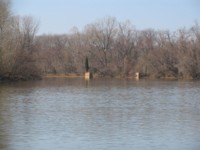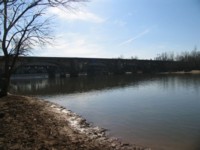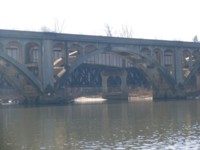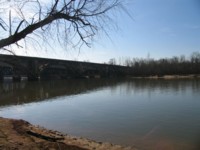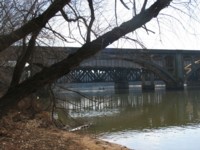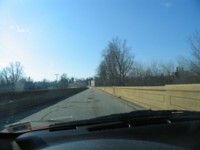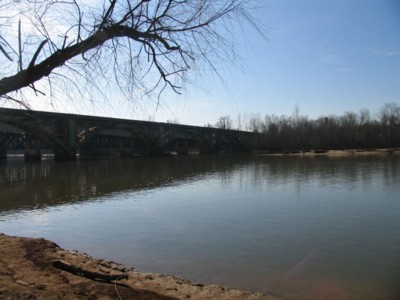 At
what is the state's most historic river crossing sits one of the state's
most historic bridges. The concrete open-spandrel seven arch Wil-Cox
Bridge that carries the southbound lanes of US 29/70 over the Yadkin River
has connected Davidson and Rowan Counties since 1922. The area where
it sits between Spencer to the south and Lexington to the north is known
as 'The Trading Ford'. The Trading Ford has seen over five centuries
of American cultural, industrial, military, and transportation history.
From Indian trading paths, failed colonization by the Spanish, travels
by troops in the American Revolution and Civil War, to a site of numerous
ferries and bridges, the Trading Ford is an important part of North Carolina
History. At
what is the state's most historic river crossing sits one of the state's
most historic bridges. The concrete open-spandrel seven arch Wil-Cox
Bridge that carries the southbound lanes of US 29/70 over the Yadkin River
has connected Davidson and Rowan Counties since 1922. The area where
it sits between Spencer to the south and Lexington to the north is known
as 'The Trading Ford'. The Trading Ford has seen over five centuries
of American cultural, industrial, military, and transportation history.
From Indian trading paths, failed colonization by the Spanish, travels
by troops in the American Revolution and Civil War, to a site of numerous
ferries and bridges, the Trading Ford is an important part of North Carolina
History.
The Wil-Cox Bridge is the third of five non rail spans to cross the Yadkin at the Trading Ford. The first two were built on the same set of piers (photo below) upriver. The first crossing, built in 1818, was designed by legendary designer Ithiel Town. Known as Beard's bridge, named after Lewis Beard who contracted Town to built the structure, the Town Lattice Truss bridge would stand for many years but would fall into disrepair after the Civil War. The next bridge, a one lane toll facility known as the Piedmont Toll Bridge, would be built on the same piers and foundation as the Beard Bridge and would last until the opening on the Wil-Cox Bridge. (1) An important crossing in the heart of the Piedmont, the Wil-Cox Bridge was appropriated for construction in the NC Highway Act of 1921 (2). Construction would begin immediately and it would open in 1924 at a cost of $212,000 (3). The bridge carried the Central Highway, NC 10, which would later become US 29/70 over the river. The bridge now one of six of its style remaining in the state is nearly 1,300 feet in length and consists of seven 150 foot long open-spandrel arches. The bridge's odd name comes from the two highway commissioners from the two regions the bridge connects, W.E. Wilkinson of Charlotte and Elwood Cox of High Point. (2) After years of increasing traffic, a second crossing was built between the Wil-Cox bridge and the railroad bridge in 1951. The new bridge carried northbound traffic towards Lexington and the Wil-Cox southbound traffic to Spencer and Salisbury. The fifth and final bridge that has been built to cross the Yadkin was finished in 1960 when Interstate 85 was completed in the area. In the years since, traffic has increased on Interstate 85 where the highway is out of date. As a result the state is planning to rebuild the highway from four to eight lanes including a new bridge over the Yadkin River. This sixth crossing and widening project has placed the Wil-Cox bridge in jeopardy. The eighty year old bridge was planned to be demolished by the state as part of the Interstate project; however, a local group called "The Bridge Group" was successfully able to lobby the state for the bridges preservation as a regional historical artifact. The bridge when closed will be a pedestrian bridge as part of a regional greenway system. (2) All photos on this page were taken by William Lawson; January 1, 2005. |
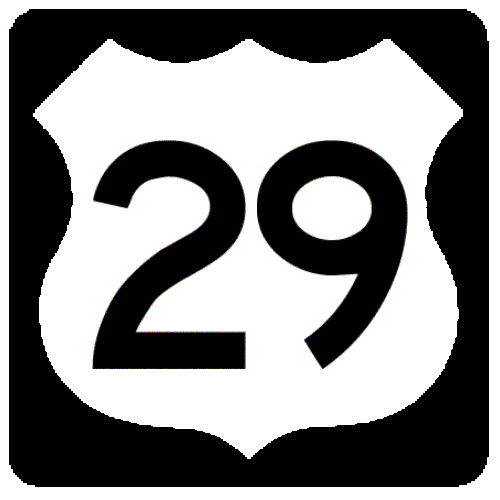 The Piedmont's Highway: Wil-Cox Bridge
The Piedmont's Highway: Wil-Cox Bridge
